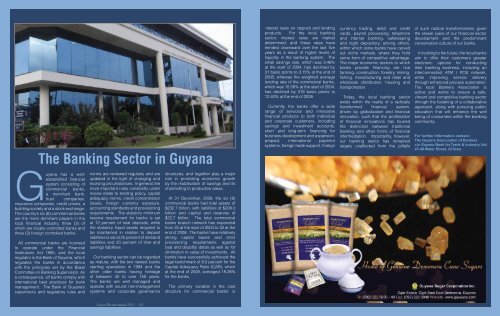Download PDF - The Georgetown Chamber of Commerce & Industry
Download PDF - The Georgetown Chamber of Commerce & Industry
Download PDF - The Georgetown Chamber of Commerce & Industry
Create successful ePaper yourself
Turn your PDF publications into a flip-book with our unique Google optimized e-Paper software.
<strong>The</strong> Banking Sector in Guyana<br />
Guyana has a wellestablished<br />
financial<br />
system consisting <strong>of</strong><br />
commercial banks,<br />
a merchant bank,<br />
trust companies,<br />
insurance companies, credit unions, a<br />
building society and a stock exchange.<br />
<strong>The</strong> country’s six (6) commercial banks<br />
are the more dominant players in the<br />
local financial industry, three (3) <strong>of</strong><br />
which are locally controlled banks and<br />
three (3) foreign controlled banks.<br />
All commercial banks are licensed<br />
to operate under the Financial<br />
Institutions Act 1995, and the local<br />
regulator is the Bank <strong>of</strong> Guyana, which<br />
regulates the banks in accordance<br />
with the principles set by the Basel<br />
Committee on Banking Supervision. As<br />
a consequence, all banks comply with<br />
international best practices for bank<br />
management. <strong>The</strong> Bank <strong>of</strong> Guyana’s<br />
supervisory and regulatory rules and<br />
norms are reviewed regularly and are<br />
updated in the light <strong>of</strong> changing and<br />
evolving circumstances. In general, the<br />
more important rules constantly under<br />
review relate to lending policy, capital<br />
adequacy norms, credit concentration<br />
issues, foreign currency exposure,<br />
accounting standards and provisioning<br />
requirements. <strong>The</strong> statutory minimum<br />
reserve requirement for banks is set<br />
at 12 percent <strong>of</strong> total deposits, while<br />
the statutory liquid assets required to<br />
be maintained in relation to deposit<br />
liabilities is set at 25 percent <strong>of</strong> demand<br />
liabilities and 20 percent <strong>of</strong> time and<br />
savings liabilities.<br />
Our banking sector can be regarded<br />
as mature, with the two newest banks<br />
starting operations in 1994 and the<br />
other older banks having heritage<br />
<strong>of</strong> between 40 to over 150 years.<br />
<strong>The</strong> banks are well managed and<br />
operate with sound risk-management<br />
systems and corporate governance<br />
Guyana Business 2010 | 60<br />
structures, and together play a major<br />
role in promoting economic growth<br />
by the mobilisation <strong>of</strong> savings and its<br />
channelling to productive areas.<br />
At 31 December, 2008, the six (6)<br />
commercial banks had total assets <strong>of</strong><br />
$232.7 billion, with liabilities <strong>of</strong> $208.0<br />
billion and capital and reserves <strong>of</strong><br />
$22.7 billion. <strong>The</strong> total commercial<br />
banks branch network has expanded<br />
from 25 at the start <strong>of</strong> 2004 to 32 at the<br />
end <strong>of</strong> 2008. <strong>The</strong> banks have relatively<br />
strong capital bases and strict<br />
provisioning requirements against<br />
bad and doubtful debts as well as for<br />
diminution in value <strong>of</strong> investments. All<br />
banks have successfully achieved the<br />
legal benchmark <strong>of</strong> 8.0 percent for the<br />
Capital Adequacy Ratio (CAR), which<br />
at the end <strong>of</strong> 2008, averaged 18.28%<br />
for the banks.<br />
<strong>The</strong> primary variable in the cost<br />
structure for commercial banks’ is<br />
interest rates on deposit and lending<br />
products. For the local banking<br />
sector, interest rates are market<br />
determined, and these rates have<br />
trended downward over the last five<br />
years as a result <strong>of</strong> higher levels <strong>of</strong><br />
liquidity in the banking system. <strong>The</strong><br />
small savings rate, which was 3.46%<br />
at the start <strong>of</strong> 2004, has declined by<br />
31 basis points to 3.15% at the end <strong>of</strong><br />
2008, whereas the weighted average<br />
lending rate <strong>of</strong> the commercial banks,<br />
which was 15.58% at the start <strong>of</strong> 2004,<br />
has declined by 318 basis points to<br />
12.40% at the end <strong>of</strong> 2008.<br />
Currently, the banks <strong>of</strong>fer a wide<br />
range <strong>of</strong> services and innovative<br />
financial products to both individual<br />
and corporate customers, including<br />
savings and investment accounts,<br />
short and long-term financing for<br />
business development and expansion,<br />
prepaid, international payment<br />
systems, foreign trade support, foreign<br />
currency trading, debit and credit<br />
cards, payroll processing, telephone<br />
and internet banking, safekeeping<br />
and night depository, among others,<br />
within which some banks have carved<br />
out niche markets, where they hold<br />
some form <strong>of</strong> competitive advantage.<br />
<strong>The</strong> major economic sectors to which<br />
banks provide financing are rice<br />
farming, construction, forestry, mining,<br />
fishing, manufacturing and retail and<br />
wholesale distribution, housing and<br />
transportation.<br />
Today, the local banking sector<br />
exists within the reality <strong>of</strong> a radically<br />
transformed financial system,<br />
driven by globalization and financial<br />
innovation, such that the proliferation<br />
<strong>of</strong> financial innovations has blurred<br />
the distinction between traditional<br />
banking and other forms <strong>of</strong> financial<br />
intermediation. Importantly, however,<br />
our banking sector has remained<br />
largely unaffected from the pitfalls<br />
<strong>of</strong> such radical transformations given<br />
the slower pace <strong>of</strong> our financial sector<br />
development and the predominant<br />
conservative culture <strong>of</strong> our banks.<br />
In looking to the future, the local banks<br />
aim to <strong>of</strong>fer their customers greater<br />
electronic options for conducting<br />
their banking business, including an<br />
interconnected ATM / POS network,<br />
while improving service delivery<br />
through enhanced process automation.<br />
<strong>The</strong> local Bankers Association is<br />
active and works to ensure a safe,<br />
vibrant and competitive banking sector<br />
through the fostering <strong>of</strong> a collaborative<br />
approach, along with pursuing public<br />
education that will enhance the well<br />
being <strong>of</strong> consumers within the banking<br />
community.<br />
For further information contact:<br />
<strong>The</strong> Guyana Association <strong>of</strong> Bankers<br />
c/o Guyana Bank for Trade & <strong>Industry</strong> Ltd<br />
47-48 Water Street, G/Town.


